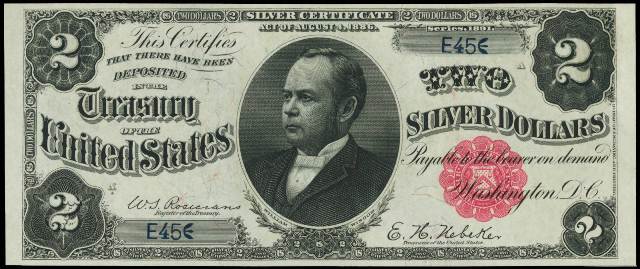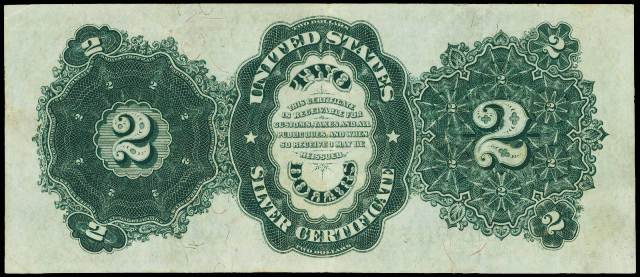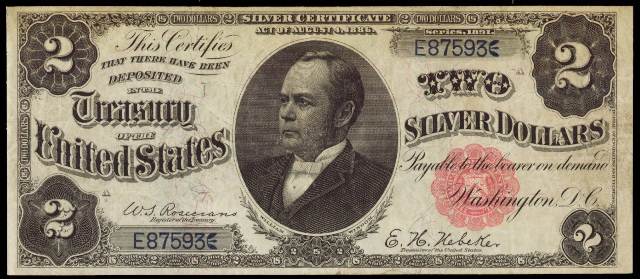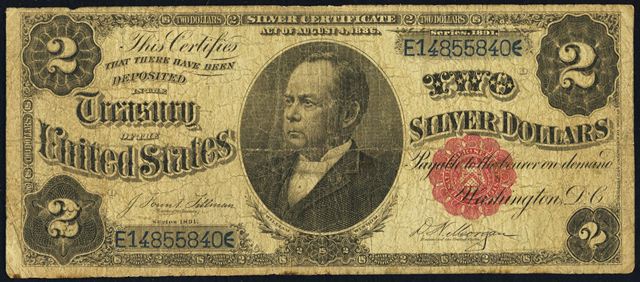Series of 1891 $2 Silver Certificate – Windom Note
History: There were only four different two dollar silver certificates printed by The United States. These were issued between 1886 and 1899. The two dollar bill we are looking at here is from the series of 1891. It was printed during a time when paper money was about 40% larger than it is today. Fortunately for collectors there are virtually no fakes, counterfeits, or reproductions from this time period. If you find a $2 bill from 1891 there is an extremely high likelihood that it is authentic and collectible. This is not necessarily a historically important or popular note. However, it is required to complete many different collections so it is in demand.
Nickname: Most collectors refer to 1891 $2 silver certificates as Windoms or a Windom; Windom being the man pictured on the 1891 $2 bill. William Windom was the 33rd treasurer of the United States. He was also a famous politician who served the state of Minnesota. He only appeared on paper money for one year. So when you say Windom it won’t get confused with any other issues.
Other Facts: It is interesting to note that for some reason the 1891 $2 silver certificate is a complete redesign from the 1886 series. One, five, ten, and twenty dollar silver certificates that were printed in 1891 all have the same design as the same denominations from 1886. However, the 1886 $2 silver certificate features a portrait of Winfield Scott Hancock and the 1891 $2 bill has a portrait of William Windom. William Windom died in 1891. So I guess it was decided that in order to honor him they would kick Hancock off the two dollar bill and put Windom up instead. It is amazing how fast the government used to move back then.
Values and Grading: There really aren’t any important or rare varieties for the series of 1891 $2 silver certificate. It was only issued for about five years. It was printed in the time before replacement star notes were issued, so that will never be a factor. There are lots of low serial number Windom notes known to exist. So even having a low serial number will not add a significant premium to the bill. 1891 $2 bills come with two different signature combinations. They were either signed by Rosecrans and Nebeker or by Tillman and Morgan. Both signatures are equally rare. The value really just comes down to condition. Our guide below shows you how to grade and value your 1891 $2 silver certificate. We would encourage you to contact us if you need more information.
Choice Uncirculated or Better: There are dozens of super high grade 1891 $2 silver certificates available on the market today. Most notes have great margins and many have serial numbers under 100. This is a direct result of someone decades ago saving large consecutive runs of 1891 $2 bills. The price range here is huge depending on centering and other factors. A nice 63 might only sell for $3,000, while a 67 could be worth more than $10,000. You really need to work with an expert if you have something this high grade. There are very small nuances that significantly affect values.

This 1891 $2 Silver Certificate Has Perfectly Square Boardwalk Margins
Extremely Fine to About Uncirculated: There is not a huge supply of accurately graded 1891 $2 silver certificates in the XF or AU grade. Most examples we see are brand new or heavily circulated. The 40 to 58 range is what many people call a “collector” grade. That means that the note has a slight imperfection like a fold or blemish that keeps it out of the uncirculated grades so it becomes many times cheaper, and thus becomes affordable for the average collector. Most 1891 $2 bills in this range will sell for between $750 and $1,500.

This 1891 $2 Silver Certificate Is A Couple Of Folds Away From Being Perfect
Fine to Very Fine: This is a grade range that can confuse non-collectors. We have an 1891 $2 silver certificate pictured that has been graded as Fine 15. You really can’t see any folds. This happens when a note has circulated to the point that the paper can’t hold a strong fold. So people tend to think it is in perfect condition. However, if you held this note in person you would see that the paper is soft and has been folded a countless number of times. This note is attractive for the grade. A fine 12 would probably be slightly dirtier, while a Very Fine 35 could be bright white with just a handful of folds. The note we have pictured is probably worth $300. You can add or subtract $150 based on condition and still be in the same grade range.

Most 1891 $2 Bills You See Will Be Lightly Circulated Like This Example
Very Good and Lower: We pictured an 1891 $2 silver certificate that graded as very good 10. A quick glance shows that the paper is dirty and soft. The colors are still surprisingly bright, especially in the seal and serial number. Most pieces of paper money that grade between a 1 and 10 on a scale of 70 will look worse. You will find damaged margins, stains, rust, writing, tears, splits, and even missing pieces. The note we have pictured is probably worth $150. Obviously if the condition is worse then the value will be less than $150.

Despite Being Well-Used There Is Still An Active Market For Circulated 1891 $2 Bills
Need an Appraisal or Offer? We are actively buying any and all 1891 $2 silver certificates. If you would like a price quote on yours then just send us scans or digital photos of what you have. We will respond quickly with a free appraisal and our best offer. Sales@AntiqueMoney.com


